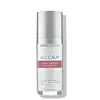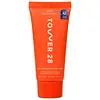What's inside
What's inside
 Key Ingredients
Key Ingredients

 Benefits
Benefits

 Concerns
Concerns

 Ingredients Side-by-side
Ingredients Side-by-side

Titanium Dioxide 11.6%
Cosmetic ColorantZinc Oxide 8.6%
Cosmetic ColorantCyclopentasiloxane
EmollientCaprylic/Capric Triglyceride
MaskingDimethicone Crosspolymer
Emulsion StabilisingWater
Skin ConditioningNiacinamide
SmoothingDimethicone/Vinyl Dimethicone Crosspolymer
Skin ConditioningDisteardimonium Hectorite
StabilisingPropylene Carbonate
SolventDisodium Lauriminodipropionate Tocopheryl Phosphates
CleansingCrithmum Maritimum Extract
Skin ConditioningMagnolia Officinalis Bark Extract
AntimicrobialZingiber Officinale Root Extract
MaskingMagnesium Carboxymethyl Beta-Glucan
Skin ConditioningJojoba Esters
EmollientBisabolol
MaskingSilica
AbrasivePolyhydroxystearic Acid
EmulsifyingDimethiconol
EmollientAlumina
AbrasiveGlyceryl Behenate/Eicosadioate
EmollientPhenoxyethanol
PreservativeTriethoxycaprylylsilane
Ethylhexylglycerin
Skin ConditioningTocopherol
AntioxidantDehydroacetic Acid
PreservativeBenzoic Acid
MaskingGlycolic Acid
BufferingChloroacetic Acid
CI 77288
Cosmetic ColorantIron Oxides
Titanium Dioxide 11.6%, Zinc Oxide 8.6%, Cyclopentasiloxane, Caprylic/Capric Triglyceride, Dimethicone Crosspolymer, Water, Niacinamide, Dimethicone/Vinyl Dimethicone Crosspolymer, Disteardimonium Hectorite, Propylene Carbonate, Disodium Lauriminodipropionate Tocopheryl Phosphates, Crithmum Maritimum Extract, Magnolia Officinalis Bark Extract, Zingiber Officinale Root Extract, Magnesium Carboxymethyl Beta-Glucan, Jojoba Esters, Bisabolol, Silica, Polyhydroxystearic Acid, Dimethiconol, Alumina, Glyceryl Behenate/Eicosadioate, Phenoxyethanol, Triethoxycaprylylsilane, Ethylhexylglycerin, Tocopherol, Dehydroacetic Acid, Benzoic Acid, Glycolic Acid, Chloroacetic Acid, CI 77288, Iron Oxides
Water
Skin ConditioningGlycerin
HumectantCetyl Ethylhexanoate
EmollientCaprylic/Capric Triglyceride
MaskingPropanediol
Solvent1,2-Hexanediol
Skin ConditioningGlyceryl Stearate
EmollientCetearyl Alcohol
EmollientMicrocrystalline Cellulose
AbsorbentSodium Polyacrylate Starch
AbsorbentSclerotium Gum
Emulsion StabilisingTriolein
Skin ConditioningPotassium Cetyl Phosphate
EmulsifyingBehenyl Alcohol
EmollientAllantoin
Skin ConditioningCeramide NP
Skin ConditioningGlyceryl Dioleate
EmollientCellulose Gum
Emulsion StabilisingSodium Phytate
Pentylene Glycol
Skin ConditioningSodium Acetylated Hyaluronate
HumectantSodium Hyaluronate
HumectantSodium Hyaluronate Crosspolymer
HumectantHydrolyzed Sodium Hyaluronate
Skin ConditioningEthylhexylglycerin
Skin ConditioningWater, Glycerin, Cetyl Ethylhexanoate, Caprylic/Capric Triglyceride, Propanediol, 1,2-Hexanediol, Glyceryl Stearate, Cetearyl Alcohol, Microcrystalline Cellulose, Sodium Polyacrylate Starch, Sclerotium Gum, Triolein, Potassium Cetyl Phosphate, Behenyl Alcohol, Allantoin, Ceramide NP, Glyceryl Dioleate, Cellulose Gum, Sodium Phytate, Pentylene Glycol, Sodium Acetylated Hyaluronate, Sodium Hyaluronate, Sodium Hyaluronate Crosspolymer, Hydrolyzed Sodium Hyaluronate, Ethylhexylglycerin
 Reviews
Reviews

Ingredients Explained
These ingredients are found in both products.
Ingredients higher up in an ingredient list are typically present in a larger amount.
This ingredient is an emollient, solvent, and texture enhancer. It is considered a skin-softener by helping the skin prevent moisture loss.
It helps thicken a product's formula and makes it easier to spread by dissolving clumping compounds.
Caprylic Triglyceride is made by combining glycerin with coconut oil, forming a clear liquid.
While there is an assumption Caprylic Triglyceride can clog pores due to it being derived from coconut oil, there is no research supporting this.
Learn more about Caprylic/Capric TriglycerideEthylhexylglycerin (we can't pronounce this either) is commonly used as a preservative and skin softener. It is derived from glyceryl.
You might see Ethylhexylglycerin often paired with other preservatives such as phenoxyethanol. Ethylhexylglycerin has been found to increase the effectiveness of these other preservatives.
Water. It's the most common cosmetic ingredient of all. You'll usually see it at the top of ingredient lists, meaning that it makes up the largest part of the product.
So why is it so popular? Water most often acts as a solvent - this means that it helps dissolve other ingredients into the formulation.
You'll also recognize water as that liquid we all need to stay alive. If you see this, drink a glass of water. Stay hydrated!
Learn more about Water